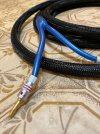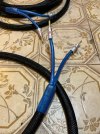- Thread Starter
- #121
A general observation I have made about audio forums, and let me clarify, not ASR, there are frequent or top posters that make it such a point to bring about the errors of others and to correct them, it makes me wonder when they actually have time to sit down and reap the rewards of their hobby. It would appear their mandate is to clearly dictate how knowledgeable they are over everyone else. In my opinion, it would discourage new posters with a keen idea of participating in the community.
I like to spend my time lurking here because I feel more aligned with the group. However, when I have a contribution I would like to make, I have a defeatist attitude before I even start.
Today I finally finished my 12 ga. 16mm rubber surrounded speakers cables. It is 16mm 12/3 with the 3rd wire snipped. I had been waiting on the Nakamichi banana plugs and speaker cable pants. I got everything finished today, one 6' cable and one 12' cable.
My original plan was to inject a 1 kHz signal down one end, monitor it on my oscilloscope on the other end, then take my portable spectrum analyzer with Comm Power PS-400 near field probes connected to my SA to see if I could detect any spurious EMF or harmonics off the input signal in a detectable hearing range. I am not sure how scientific this is in the audio realm since this is not my field of expertise, but as I was showing off my cables to my wife this afternoon, I said there are people out there that would pay thousand for what I just made.
I like to spend my time lurking here because I feel more aligned with the group. However, when I have a contribution I would like to make, I have a defeatist attitude before I even start.
Today I finally finished my 12 ga. 16mm rubber surrounded speakers cables. It is 16mm 12/3 with the 3rd wire snipped. I had been waiting on the Nakamichi banana plugs and speaker cable pants. I got everything finished today, one 6' cable and one 12' cable.
My original plan was to inject a 1 kHz signal down one end, monitor it on my oscilloscope on the other end, then take my portable spectrum analyzer with Comm Power PS-400 near field probes connected to my SA to see if I could detect any spurious EMF or harmonics off the input signal in a detectable hearing range. I am not sure how scientific this is in the audio realm since this is not my field of expertise, but as I was showing off my cables to my wife this afternoon, I said there are people out there that would pay thousand for what I just made.



